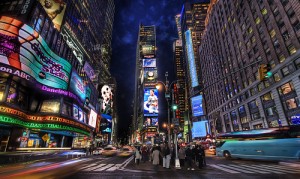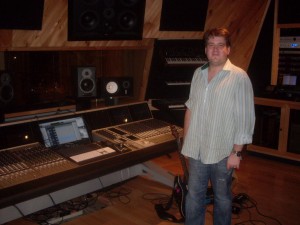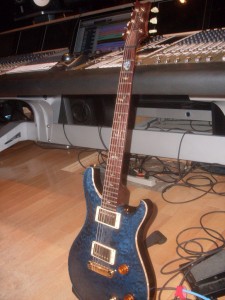Tainted Blue Stage II: The Story of an NYC Studio Console Switch
MIDTOWN, MANHATTAN: Hard to believe, but it’s been almost five years exactly since the storied penthouse of Quad Studios was sold and became an entirely separate facility, Tainted Blue.
Then, as now, the top-end NYC studio scene felt like a big mystery, and many a big room has gone since 2005 (Sony, the Hit Factory, Legacy A509, Sound on Sound, Clinton Recording all RIP). But at the respectfully competitive Times Square address of 723 Seventh Avenue, which houses Quad and Tainted Blue, as well as Premier Studios NY on consecutive floors, the tracking/mixing beat goes furiously on.
Today, Tainted Blue owner Andrew Koss feels wiser – and no doubt older – as the landscape continues to shift. For the world-class studios that remain, the choice of large format console remains one of the most critical decisions, and Koss just shifted gears in a surprising way: His advanced Lawrence P. Swist-designed control room no longer houses an SSL 9080J, but a newly acquired Euphonix System 5.
Tainted Blue’s switch from a flagship analog board to a digital audio mixing system raised a lot of eyebrows citywide, but as we were reminded in our latest chat with Koss: everything happens for a reason.
How do you feel the studio business has evolved since you opened Tainted Blue?
It’s certainly been interesting to watch the rise, fall and challenges of how studios are trying to restructure themselves in the city. But I also think there’s been a swing back in the last few years to larger production, larger sound. There was a run of the indie style, where minimal was cool, and you could do it in the bedroom with a laptop. But if you look at the Billboard Top 50 now, none of the tracks are like that today.
So I think maybe producers and musicians hit the wall, which I think I hit before I opened up the studio here — the frustrations and limitations of what you could do at home with a minimal setup. You start wanting more creativity, and a sound you just can’t capture without the acoustics of a live room.
The challenges have been that it’s a new generation of engineers, and new generation of producers who grew up with a very different education. The way they work is so different that you have to be able to cater to their needs. They’ve learned the software version, and then they come in and see the hardware version of the LA-2As and Pultecs.
We’re not catering towards the older generation of engineers, who really have their own spaces and their own environments that they work at, so we try to cater to the younger, next generation of engineers who are more comfortable in a digital format, and in a hipper more stylistically designed room, where the vibe is more important to them than it ever was to the older clients. It’s really the younger guys who want that exclusive, luxury feel and we’ve worked hard to provide that.
We built this as a boutique studio. And it’s a little more refined — the feeling when you’re here. Having a piano that’s always tuned and ready to go, instruments and drumkits at hand, and we don’t charge rental fees for any of this. They’re here to be used.
I think there’s more potential clients than we’ve seen in years. But it’s a different kind of project. Sure, people can do pre-production at home, and because of that, the project they bring in doesn’t require a week of studio time, they just need six hours. But there’s so many of those people, that it’s all right that we only get them for one day, instead of twelve-day lockouts. There’s plenty of that business out there — it’s just a different kind of booking.
What makes a large console format remain important in those considerations?
There’s certainly a lot of people who work in the box and don’t need the audio channel capacity that we have. But at the same time having a console like the Euphonix System 5, that can turn into a control surface makes our approach to that market that much easier.
That’s because if they want to they can work in software and the console can turn into a controller with the EuCon software. It caters to people that don’t necessarily need the large format console, and just want the control space and to be able to retain access to all our outboard gear. At the same time, having 116 audio channels and near infinite routing options for the people that want to work across the console give us the perfect blend of both of these worlds.
I think also that the live room and the gear is still appealing to a lot of producers: being able to track drums, live piano and multiple musicians at the same time will always have its place.
We also have clients who come in and just take their mix out of the box through our outboard gear — bounce it out of the box, and go home. They put it through the EQs, bus compressors, print it, and take it home and keep mixing. As much a fan as I am of plug-ins, there are some things I just can’t create without a Thermionic Culture Phoenix compressor, or an LA-2A, for example.
What did you consider leading up to your decision to switch to a Euphonix System 5 from an SSL 9080J?
The cost and upkeep of the SSL was becoming difficult for us in a business where we have to think outside of the box, and try to find ways to keep revenue coming in.
The energy cost of the SSL was extreme with two air conditioners running 24 hours a day, even in January! The other issue was that the younger clients didn’t have experience on an old J console. If they did, they used it rarely for what it could do, and it wasn’t getting the use that demanded having it here, as parts were starting to go and setup times were increasing. Now because of the System 5 and its Patchnet system, if we have six hours to work with an artist, I can zero the room out in :30, as opposed to two hours. If someone wants to come in and play their session from last night, they can come in, open up the files and it’s exactly where they left it, including all routing and outboard patching.
Of course, the SSL sounded great, and a big concern with the Euphonix was getting a console that a lot of people hadn’t tried themselves. It takes a little convincing to show them what it can do, and seeing that it’s not just a digital control surface. People see it and they think “ICON”, whereas this is a true console, with 116 audio channels, 24 group busses, 24 mix busses –and not just stereo because they can be in 7.1, 5.1 and stereo all at the same time.
I’ll bet a lot of manufacturers wanted to get their board into Tainted Blue next. Why did you settle on the Euphonix?
We looked at a few choices out there. There’s actually less digital consoles on the market that are geared towards music production/tracking/mixing. Many of them are post production video type workstations.
Then we met Jay Spears over at Euphonix and we started talking about the System 5. He took me over to Studio B at what’s now MSR Studios, and I had never seen anything like it. The Euphonix seemed to be the most out in front with the technology with a 40-bit point floating point processing system, being so modular that you could have control surface and audio tracks right next to each other, or wherever you wanted them – this as opposed to some consoles that are either in controller mode or audio mode, one or the other.
And the support was a big issue. Jay and his team took the time to show the staff my board, and physically set it up with my team which was pretty spectacular. Having a company large enough that I knew I could count on was really important, and having them understand we were taking a risk with them: We’re a big room in Manhattan, there’s not a lot of us left, and this was a major change.
You bought your System 5 right before Avid acquired Euphonix…
The merger with Avid is a huge plus for us. The integration with Pro Tools is going to go through the roof, now that Avid’s involved, so for our clients it will be a win-win. It will be everything the ICON is, and way more because of the actual audio processing. I believe you’ll see the System 5 becoming Avid’s flagship console.
I think for studio owners switching consoles is the next most-dreaded prospect to moving studios altogether. Was making the physical switch from the SSL to the Euphonix difficult?
The buyers were responsible, thankfully, for the decommission of the SSL, but we weren’t sure what spider webs we’d find underneath it. We did the decommission in two days, which was remarkably fast, and the installation of the Euphonix took about eight hours. The slow part of the process was the patch bay, because we had to sell the old patch bay with the SSL, which meant we had to rewire the audio DL’s into the wall, and add some new gear as well.
But we used that time to problem-solve issues with the room that have been here since it was built, reducing some noise and grounding problems. In Manhattan, there’s always issues with electricity, and (Tainted Blue Studio Manager) Sax took the time to reduce noise floor on the gear. It took a week to turn over, but the studio has never sounded this good, and it’s been here thirty years. I think they reduced noise in the mic lines by about 20 dB, which is pretty dramatic.
The System 5 setup itself couldn’t have been easier. Four rack pieces and it plugs into the wall! With Ethernet, it’s so easy. One DeltaLink handles all 116 audio channels i/o of Pro Tools. Two DigiLink cables and two SSL Alpha-Links handle all the outboard gear.
[See a time lapse video of the console switch at Tainted Blue right here:]
Now that the board’s in place, what are the impressions — yours and your clients’?
Since I work here all the time, for my work it’s the greatest thing that could have happened. The Euphonix computer controls our entire patch bay, and every time I open a session, all of my outboard gear is routed back to that session, so buss compressors, inserts, outboard EQ, reverbs, etc… are all brought back to where they were the last they were used. Obviously you have to move the knobs on the outboard gear, but the patching which was a such tedious aspect is now gone. I can A/B different vocal chains with the press of a button in real time. So it’s done a lot for me, before the session even starts.
Clients have been having a blast because it’s something new to play with, but also because we can contour the templates to their workflow. We know if they work out of the box, we’ll directly route Pro Tools to the monitoring section. Or if they want to use the control surface on one side and audio on the other, they can do that.
People love the EQs and dynamics of the System 5, because there so clean – “surgical” is the word I’d use. Reminiscent of an Oxford console to me, which is why we added some outboard gear with lots of sound — I went with outboard gear that’s dirty and crazy and fun.
There was a visual impact the SSL had, but I’ve been surprised about the number of people who have seen the way the room looks with the extra space, and say that it looks like 2010, not the late ‘90s. The 24’ LCD screen with Cinema Display dead center is an awesome way to work in an era when clients are hands-on now, not sitting in the back making calls but doing the editing and effects. It’s a clear, clean listening field and makes for a nice comfortable experience.
We’ve talked a LOT about gear just now. Any intangibles to take note of?
Just recently we’ve made Sax our studio manager. He’s been in the studio scene for 15-20 years now. He’s seen it since the heyday, and really knows what make studios succeed and fail. He’s working very hard on how the whole experience transfers on to the client.
In the end, the energy that clients feel coming in is so important. And while you’d think it would be intuitive that the gear is the most important factor, it’s not: the experience and how they feel while they’re here really matters. It’s so important.
Along with that, we’ve been out trying to find new ways to bring in business for us that are outside the box. Using the studio as more than just a place to record, be it for film, photos, and our “From the Penthouse” series where we’ve been doing small artist showcases here.
We’re really having a blast, and we’re sharing that with the people who come in — it’s a fun place to work. We’re excited to let people see that and have them create their music here.
— David Weiss
Please note: When you buy products through links on this page, we may earn an affiliate commission.









